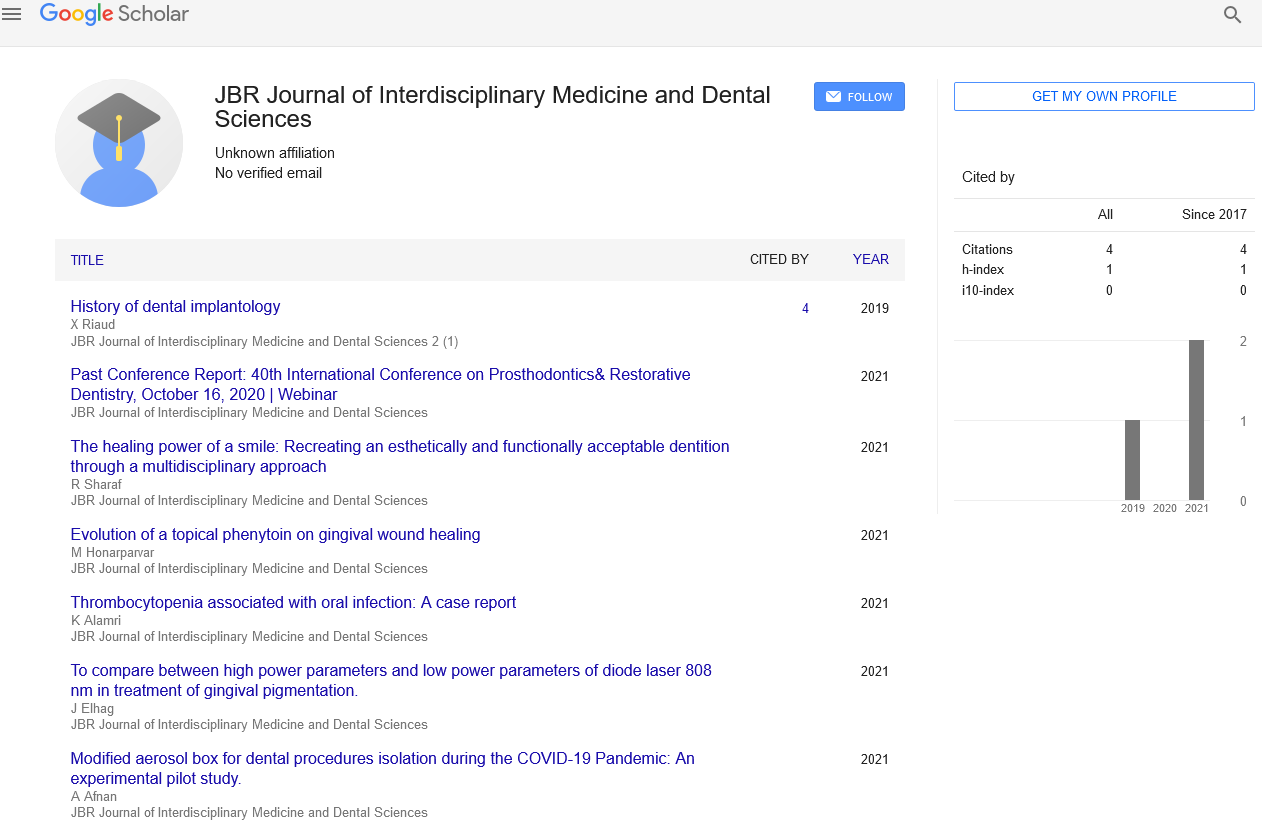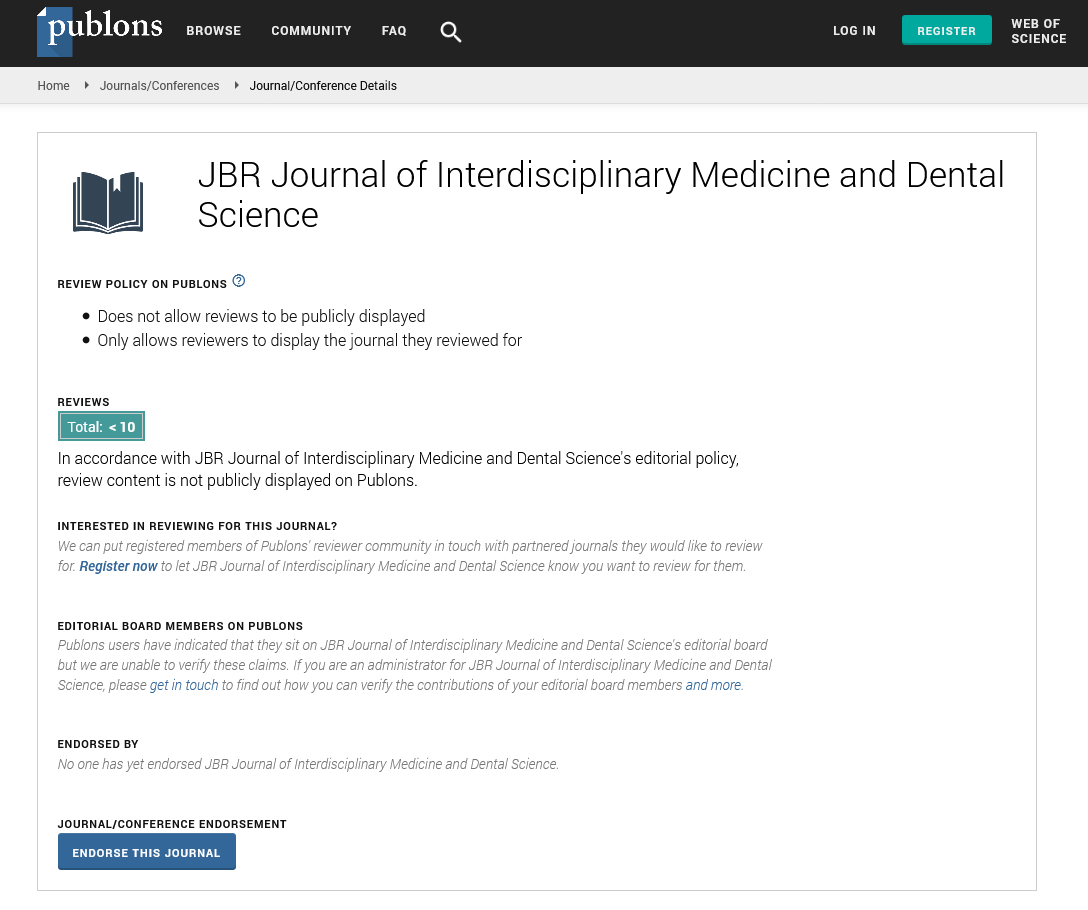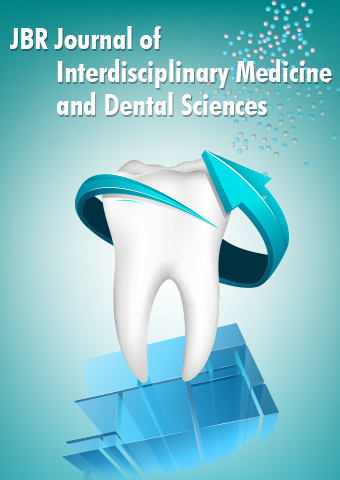Short Communication - JBR Journal of Interdisciplinary Medicine and Dental Sciences (2023) Volume 6, Issue 3
Dental Anatomy Understanding the Structure and Function of Teeth
Jain Robert*
Department of pharmacology, Australia
Department of pharmacology, Australia
E-mail: robert_j66@gmail.com
Received: 01-May-2023, Manuscript No. jimds-23-100125; Editor assigned: 04-May-2023, PreQC No. jimds-23-100125 (PQ); Reviewed: 19-May-2023, QC No. jimds-23-100125; Revised: 24-May-2023, Manuscript No. jimds-23-100125 (R); Published: 30-May-2023, DOI: 10.37532/2376- 032X.2023.6(3).32-35
Abstract
Dental anatomy is a field of study that focuses on understanding the structure and function of teeth. It encompasses the examination of primary (deciduous) and permanent teeth, their different types such as incisors, canines, premolars, and molars, as well as the various components that make up a tooth, including the crown, root, enamel, dentin, and pulp. Additionally, dental anatomy involves an exploration of the supporting structures of teeth, collectively known as the periodontium, which includes the gingiva, periodontal ligament, Cementum, and alveolar bone. By gaining insights into dental anatomy, both dental professionals and individuals can develop a deeper understanding of oral health and make informed decisions regarding oral care practices. This knowledge is essential for maintaining healthy teeth and promoting overall well-being.
Keywords
Dental • Dental anatomy • Root •pulp • Periodontium • Premolars Communication
Introduction
The human mouth is a remarkable and complex system that enables crucial functions such as biting, chewing, and speaking. At the core of this oral apparatus are the teeth, which play a vital role in the process of mastication and contribute to overall oral health [1]. Dental anatomy is a specialized field of study that focuses on understanding the structure, development, and arrangement of teeth in humans. By comprehending dental anatomy, both dental professionals and individuals can gain valuable insights into the form and function of teeth, leading to better oral care practices and a greater appreciation of this remarkable aspect of human physiology. Teeth serve as essential tools for the initial stages of digestion, enabling the breakdown of food into smaller, more manageable pieces. They also play a crucial role in articulation, aiding in the formation of sounds and facilitating clear speech [2]. Moreover, teeth contribute significantly to the aesthetic appearance of an individual’s smile, impacting self-confidence and overall facial harmony. Humans typically have two sets of teeth during their lifetime: primary (deciduous) teeth and permanent teeth. The primary dentition, commonly known as baby teeth, starts to emerge around six months of age and continues to erupt until approximately two to three years old. These primary teeth eventually shed, making way for the permanent dentition to take their place. By the age of six, the transition from primary to permanent teeth begins, and by the age of 13, most individuals have a complete set of permanent teeth [3]. The permanent dentition consists of 32 teeth, arranged in the upper and lower jaws in a specific pattern. These teeth are classified into four main types: incisors, canines, premolars (bicuspids), and molars. Each type of tooth possesses distinct characteristics that enable it to perform specific functions during the process of mastication. The incisors are the four front teeth in both the upper and lower jaws, situated at the centre of the dental arch. These teeth have a thin, sharp edge, designed for cutting and biting into food. Incisors are essential for the initial stages of food breakdown and contribute to the aesthetic appearance of the smile. Next to the incisors, we find the canines, also known as capsid. Canines have a pointed shape and are well-suited for tearing and grasping food [4]. They play a vital role in guiding the alignment of the upper and lower teeth, ensuring a balanced and functional bite. Situated behind the canines, the premolars (bicuspids) fulfil their role in the dental arch. There are eight premolars in the mouth, four in each arch. Premolars have a flat surface with two pointed cusps, which makes them ideal for crushing and grinding food particles. They serve as transitional teeth between the canines and molars, contributing to the overall efficiency of the masticatory process. The molars, positioned at the back of the dental arch, are the largest and strongest teeth in the human dentition. There are eight molars in total, with four in each quadrant of the mouth. Molars have broad, flat occlusal surfaces, featuring multiple cusps and grooves. Their primary function is to crush, grind, and chew food into smaller, more digestible pieces, facilitating proper digestion. Understanding the structure of teeth is equally important in comprehending their overall function. Each tooth comprises different structural components that contribute to its strength and durability [5]. The visible part of the tooth above the gum line is called the crown, while the portion below the gum line is known as the root. The crown is covered by enamel, the hardest substance in the human body, which provides protection against wear and tear. Beneath the enamel lies the dentin, a living tissue that makes up the bulk of the tooth structure. Dentin is a calcified substance that surrounds the tooth pulp and transmits sensory information. The pulp, located at the core of the tooth, is composed of blood vessels, nerves, and connective tissues. It extends from the crown to the tip of the root through narrow canals called root canals [6]. The pulp nourishes and supports the tooth during its development and plays a crucial role in sensory perception. Teeth do not exist in isolation but are firmly supported within the oral cavity by a complex network of tissues known as the periodontium. The periodontium includes the gingiva (gums), periodontal ligament, cemented, and alveolar bone. The gingiva forms a protective seal around the teeth, providing a barrier against bacteria and other harmful substances. The periodontal ligament connects the teeth to the surrounding alveolar bone, acting as a shock absorber during biting and chewing. Cemented, covers the root surface and helps anchor the periodontal ligament fibres. Finally, the alveolar bone forms the tooth sockets (alveoli) and provides a stable foundation for the teeth [7].
Material and Methods
Primary and permanent teeth
Humans typically have two sets of teeth during their lifetime: primary (deciduous) teeth and permanent teeth. Primary teeth, also known as baby teeth, are the first set of teeth that erupt in the oral cavity. These teeth begin to appear around six months of age and are gradually replaced by permanent teeth starting from around the age of six. By the age of 13, most individuals have a complete set of permanent teeth, which consists of 32 teeth, including four types: incisors, canines, premolars, and molars [8].
Incisors: The incisors are the four front teeth in both the upper and lower jaws, positioned at the centre of the dental arch. They have a thin, sharp edge designed for cutting and biting into food. The incisors play a crucial role in the initial stages of mastication and contribute to the aesthetics of a person’s smile.
Canines: The canines, also known as capsids, are the next teeth adjacent to the incisors. These teeth have a pointed shape and are well-suited for tearing and grasping food. Canines play an important role in guiding the alignment of the upper and lower teeth and are crucial for a balanced and functional bite [9].
Premolars: The premolars, also referred to as bicuspids, are located behind the canines. There are a total of eight premolars in the mouth, with four in each arch. Premolars have a flat surface with two pointed cusps, making them ideal for crushing and grinding food particles. They serve as transitional teeth between the canines and molars [10].
Molars: Molars are the largest and strongest teeth in the mouth, situated at the back of the dental arch. There are eight molars in the permanent dentition, with four in each quadrant. These teeth have broad, flat occlusal surfaces, featuring multiple cusps and grooves. Molars are responsible for crushing, grinding, and chewing food into smaller pieces, facilitating proper digestion.
Tooth structure: Each tooth has distinct structural components that contribute to its function and overall integrity. The visible part of the tooth above the gumline is called the crown, while the portion below the gumline is known as the root. The enamel, the hardest substance in the human body, covers the crown and provides protection against wear and tear. The dentin lies beneath the enamel and makes up the bulk of the tooth structure. It is a living tissue that contains microscopic tubules connecting to the innermost part of the tooth called the pulp. The pulp is composed of blood vessels, nerves, and connective tissues that nourish and support the tooth during its development. The pulp extends from the crown to the tip of the root through narrow canals known as root canals. The root canal system connects the pulp to the surrounding tissues and allows for the exchange of nutrients and sensory information.
Periodontium and supporting structures
Teeth are not isolated structures but are firmly supported within the oral cavity by a complex network of tissues collectively known as the periodontium. The periodontium consists of the gingiva (gums), periodontal ligament, Cementum, and alveolar bone. The gingiva, or gums, form a protective seal around the teeth and provide a barrier against bacteria and other harmful substances. The periodontal ligament attaches the teeth to the surrounding alveolar bone and acts as a shock absorber during biting and chewing. Cementum covers the root surface and helps anchor the periodontal ligament fibres. The alveolar bone forms the tooth sockets (alveoli) and provides a stable foundation for the teeth.
Discussion
The human mouth is an incredible marvel of nature, designed to perform various functions such as biting, chewing, and speaking. At the core of this oral system are the teeth, which play a vital role in the process of mastication and contribute to overall oral health. Dental anatomy is the branch of anatomy that focuses on the study of the structure, development, and arrangement of teeth in humans. By understanding dental anatomy, both dental professionals and individuals can gain valuable insights into the form and function of teeth, leading to better oral care and a greater appreciation of this remarkable aspect of human physiology.
Conclusion
Dental anatomy is a crucial aspect of oral health and plays a significant role in understanding the structure, function, and development of teeth. By delving into the different types of teeth, their unique characteristics, and the supporting structures within the oral cavity, dental professionals and individuals can develop a deeper appreciation for oral health. The study of dental anatomy enables dental professionals to accurately diagnose and treat various dental conditions, ensuring the maintenance of healthy teeth and gums. It also guides them in performing dental procedures such as extractions, fillings, and restorations with precision and efficacy. For individuals, understanding dental anatomy provides valuable insights into proper oral care practices. By recognizing the role of each tooth type and the importance of maintaining healthy supporting structures like the periodontium, individuals can make informed decisions regarding their oral hygiene routines. Regular brushing, flossing, and dental check-ups are essential for maintaining optimal dental health and preventing oral diseases such as tooth decay and gum disease. Moreover, knowledge of dental anatomy enhances an individual’s appreciation of their smile’s aesthetics. By understanding the arrangement of teeth and their impact on facial harmony, individuals can seek orthodontic treatments if needed to correct misalignments or irregularities, thereby enhancing their confidence and overall well-being. In conclusion, dental anatomy is a fundamental aspect of oral health. By understanding the structure and function of teeth, individuals can make informed decisions regarding oral care practices, dental professionals can provide effective treatments, and both can appreciate the significance of maintaining healthy teeth and gums for a lifetime of optimal oral health.
References
- Aksu M, Kocadereli I. Arch width changes in extraction and non-extraction treatment in class I patients. Angle Orthod. 75, 948–952 (2005).
- Kahl Nieke B, Fischbach H, Schwarz CW et al. Treatment and post retention changes in dental arch width dimensions a long-term evaluation of influencing cofactors. Am J Orthod. 109, 368–378 (1996).
- Stifter J, A study of Pont’s, Howes’ Rees’ Neff’s and Bolton’s analyses on Class I adult dentitions. Angle Orthod. 28, 215–225 (1958).
- Rees DJ. A method for assessing the proportional relation of apical bases and contact diameters of the teeth. Am. J. Orthod. 39, 695–707 (1953).
- Pont A. Der Zahn-index in der orthodontie. Zahnarztuche Orthop. 3, 306–321 (1909).
- Al-Omari IK, Duaibis RB, Al-Bitar ZB et al. Application of Pont’s Index to a Jordanian population. Eur. J. Orthod. 29, 627–631 (2007).
- Dhakal J, Shrestha RM, Pyakurel U et al. Assessment of Validity of Pont’s Index and Establishment of Regression Equation to Predict Arch Width in Nepalese Sample. Orthod J 4, 12–16 (2014).
- Lohakare S. Application of Pont’s Index to Gujrati Population. J Med Sci Clin Res. 6, 171–178 (2018).
- Dalidjan M, Sampson W, Townsend G et al. Prediction of dental arch development: An assessment of Pont’s Index in three human populations. Am J Orthod Dentofac Orthop.107, 465–475 (1995).
- Rykman A, Smailiene D. Application of Pont’s Index to Lithuanian Individuals: A Pilot Study. J Oral Maxillofac Res. 6, e4 (2015).
Indexed at, Google Scholar, Crossref
Indexed at, Google Scholar, Crossref
Indexed at, Google Scholar, Crossref
Indexed at, Google Scholar, Crossref
Indexed at, Google Scholar, Crossref
Indexed at, Google Scholar, Crossref
Indexed at, Google Scholar, Crossref
Indexed at, Google Scholar, Crossref


